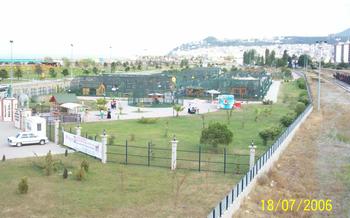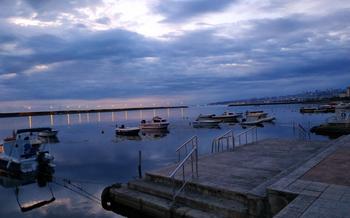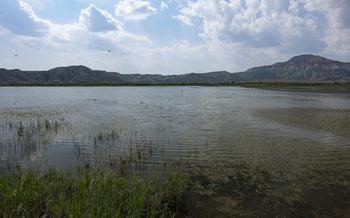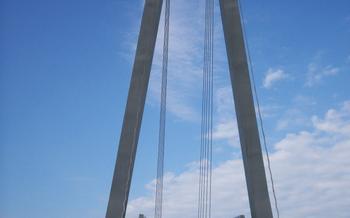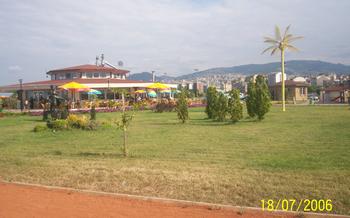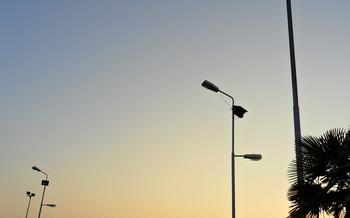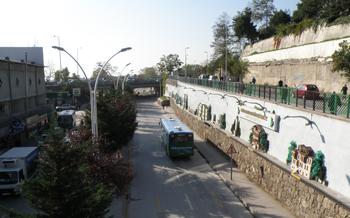
Kızılırmak Delta Wetland and Bird Sanctuary
- Kızılırmak Delta Wetland and Bird Sanctuary: A Birdwatcher's Paradise
- Exploring the Diverse Habitats
- Spotting Rare and Endemic Bird Species
- Experiencing the Seasonal Changes
- Birdwatching Hides and Observation Towers
- Birdwatching Equipment and Tips
- Bird Photography and Videography
- Guided Tours and Local Guides
- Visitor Center and Educational Programs
- Sustainable Tourism Practices
- Local Culture and Traditions
- Planning Your Trip
- Getting to the Sanctuary
- Insider Tip: Hidden Gems and Secret Spots
Kızılırmak Delta Wetland and Bird Sanctuary: A Birdwatcher's Paradise
Nestled in the heart of Samsun, Turkey, the Kızılırmak Delta Wetland and Bird Sanctuary is a haven for bird enthusiasts and nature lovers alike. Established in 1994, this 21,000-hectare sanctuary is a Ramsar-designated wetland of international importance, renowned for its exceptional biodiversity and rich birdlife. The sanctuary encompasses a diverse mosaic of habitats, including freshwater marshes, salt flats, reedbeds, grasslands, and forests, providing a vital refuge for a staggering array of bird species.
The Kızılırmak Delta is a critical stopover site for migratory birds along the East African-West Asian flyway, hosting over 300 species of birds throughout the year. During the spring and autumn migrations, the sanctuary teems with hundreds of thousands of birds, creating a spectacle that is truly breathtaking. The sanctuary also supports a significant population of breeding birds, with many species finding ideal nesting and feeding grounds within its diverse habitats.
Conservation efforts in the Kızılırmak Delta have been instrumental in protecting its unique ecosystem and ensuring the well-being of its avian inhabitants. Sustainable tourism initiatives have been implemented to balance the needs of bird conservation with the responsible enjoyment of this natural paradise.
Exploring the Diverse Habitats
The Kızılırmak Delta Wetland and Bird Sanctuary boasts a rich tapestry of habitats that provide refuge and sustenance to a diverse array of bird species. From the vast expanse of glistening wetlands to the tranquil grasslands and lush forests, each habitat harbors its own unique assemblage of birds.
In the sprawling wetlands, waterbirds reign supreme. Majestic herons and egrets stalk the shallows, their long legs probing the water for fish and amphibians. Graceful ducks and geese glide across the surface, their wings beating in unison. Coots and grebes dive and resurface, their calls echoing across the marsh.
Venturing into the grasslands, visitors are greeted by a chorus of larks and pipits, their sweet melodies filling the air. Wheatears and buntings flit among the grasses, their colorful plumage blending seamlessly with the surrounding vegetation. Raptors, such as kestrels and harriers, soar overhead, scanning the ground for prey.
The sanctuary's forests offer a haven for a different avian community. Warblers and flycatchers flit among the branches, their vibrant colors a stark contrast to the verdant foliage. Woodpeckers and nuthatches clamber up tree trunks, their beaks tapping rhythmically as they search for insects and nuts.
Guided nature walks and birdwatching tours are available for those who wish to delve deeper into the sanctuary's diverse habitats and uncover the secrets of its feathered inhabitants. These tours, led by experienced naturalists, provide an opportunity to learn about the ecology of the sanctuary and the remarkable adaptations of its birdlife.
Spotting Rare and Endemic Bird Species
The Kızılırmak Delta Wetland and Bird Sanctuary is home to a remarkable diversity of bird species, including many rare and endemic species that are found nowhere else in the world. These species are of great importance for conservation and attract bird enthusiasts from around the globe.
One of the most sought-after birds in the sanctuary is the Dalmatian Pelican, a large, striking bird with a long, pink bill and a wingspan of up to 3 meters. This pelican is a winter visitor to the sanctuary and can be seen in large flocks feeding in the shallow waters.
Another rare species is the Pygmy Cormorant, the smallest cormorant in the world. It is a shy and elusive bird that prefers to nest in dense reed beds. With its dark plumage and bright red eyes, the Pygmy Cormorant is a delight to spot.
The sanctuary is also home to a number of endemic bird species, including the Kızılırmak Reed Warbler and the Turkish Greenfinch. These species are found nowhere else in the world and are of great significance for conservation.
To increase your chances of spotting these rare and endemic bird species, it is important to visit the sanctuary during the right season. Spring and autumn are the best times of year to see migratory birds, while summer is the best time to observe breeding birds. Guided nature walks and birdwatching tours can also help you find and identify these special birds.
Experiencing the Seasonal Changes
The Kızılırmak Delta Wetland and Bird Sanctuary is a dynamic ecosystem that undergoes remarkable seasonal changes throughout the year.
Each season offers a unique spectacle for birdwatchers, as the sanctuary's diverse habitats transform and attract different species.
In spring, the sanctuary bursts into life as migratory birds return from their wintering grounds. The wetlands teem with breeding waterfowl, including ducks, geese, and herons. The grasslands echo with the songs of warblers, finches, and buntings, while the forests resonate with the calls of cuckoos, woodpeckers, and owls. This is an ideal time to witness the spectacular migration of storks, pelicans, and cranes, as they soar overhead in vast formations.
Summer brings a different kind of magic to the sanctuary. The wetlands become a nursery for young birds, as ducklings, goslings, and chicks fledge and explore their surroundings. The grasslands provide nesting sites for ground-nesting birds, such as larks, pipits, and wheatears. The forests offer refuge for tree-nesting species, such as eagles, hawks, and falcons.
In autumn, the sanctuary transforms again as migratory birds prepare for their long journey south. The wetlands fill with wading birds, such as egrets, ibises, and spoonbills, which feed on the abundant aquatic life. The grasslands host flocks of buntings, larks, and finches, which gather to feed on seeds and insects. The forests reverberate with the calls of migrating thrushes, blackbirds, and warblers.
Winter brings a quieter time to the sanctuary, as many bird species have departed for warmer climates. However, the sanctuary still provides a haven for wintering waterfowl, such as ducks, geese, and swans, which find food and shelter in the wetlands. The grasslands and forests also offer refuge for resident bird species, such as woodpeckers, nuthatches, and tits, which can be spotted foraging for food among the trees and shrubs.
Birdwatching Hides and Observation Towers
Throughout the sanctuary, strategically placed birdwatching hides and observation towers offer unparalleled opportunities to observe and photograph birds without disturbing their natural behavior. These purpose-built structures provide a comfortable and concealed space for birdwatchers to spend hours observing the diverse avian life.
The hides and towers are carefully positioned near key bird habitats, such as wetlands, grasslands, and forests, allowing visitors to get close to a wide variety of species. Equipped with viewing windows and comfortable seating, these facilities provide an immersive experience that enables birdwatchers to capture stunning photographs and videos.
Using birdwatching hides and observation towers requires proper etiquette to minimize disturbance to the birds. Visitors are advised to remain quiet, avoid sudden movements, and use camouflage clothing and accessories to blend into the surroundings. By following these guidelines, birdwatchers can enjoy the sanctuary's avian wonders without causing any harm.
To maximize your birdwatching experience, arrive early in the morning or late in the afternoon, when birds are most active. Be patient and take your time observing the birds' behavior. Use a field guide or binoculars to identify different species, and keep a notebook to record your sightings. With a little luck and patience, you'll be rewarded with unforgettable encounters with the sanctuary's feathered inhabitants.
Birdwatching Equipment and Tips
Whether you're a seasoned birdwatcher or just starting out, having the right equipment and understanding basic techniques can greatly enhance your birdwatching experience. Essential gear includes binoculars, a field guide, and a notebook for recording your observations. Binoculars with 8x or 10x magnification are a good choice for most birdwatching situations. A field guide specific to the region you're visiting is invaluable for identifying bird species.
Basic birdwatching techniques include scanning the area with your binoculars, listening for bird calls, and using your field guide to identify the birds you see. Patience and practice are key to improving your birdwatching skills. Observe birds from a distance and avoid making sudden movements to minimize disturbance. Remember, birdwatching is about enjoying the beauty and diversity of nature while respecting the wildlife you encounter.
Bird Photography and Videography
Capturing the beauty and diversity of the birdlife in Kızılırmak Delta Wetland and Bird Sanctuary through photography and videography is a rewarding experience. Whether you're a seasoned professional or an enthusiastic amateur, the sanctuary offers ample opportunities to hone your skills and create stunning images.
To capture stunning bird photographs, it's crucial to select the right camera equipment. A DSLR or mirrorless camera with a telephoto lens is ideal for capturing close-up shots of birds. A tripod is also essential for stability, especially when shooting at slow shutter speeds.
Understanding the basics of bird photography is key to success. Learn about the different types of bird photography, such as flight shots, portraits, and action shots. Familiarize yourself with the camera settings, including shutter speed, aperture, and ISO, to achieve the desired results.
Patience and observation are essential virtues for bird photographers. Take the time to study the birds' behavior, their preferred habitats, and their daily routines. This will help you anticipate their movements and capture those fleeting moments of beauty.
Ethical considerations are paramount when photographing wildlife. Avoid disturbing the birds or their nesting sites. Maintain a respectful distance and use camouflage to minimize your impact on their natural behavior.
Post-processing techniques can enhance your bird photos, bringing out the colors and details. Use software such as Adobe Photoshop or Lightroom to adjust exposure, contrast, and white balance. Experiment with creative editing techniques to create unique and eye-catching images.
By following these tips and guidelines, you'll be well-equipped to capture the magic of the Kızılırmak Delta Wetland and Bird Sanctuary through the lens of your camera. Share your creations with the world and inspire others to appreciate the beauty and diversity of this incredible sanctuary.
Guided Tours and Local Guides
If you're a novice birdwatcher or simply want to enhance your experience, consider hiring a local guide. These experienced professionals can help you identify and learn about the various bird species, as well as provide insights into the sanctuary's unique ecosystem. They can also lead you to the best birdwatching spots and help you avoid disturbing the wildlife.
When choosing a guide, look for one who is licensed and experienced, and who is familiar with the sanctuary's birdlife. You can find guides through local tourism agencies or online platforms. Be sure to read reviews and ask for recommendations from other birdwatchers.
A guided tour can be a great way to learn more about the Kızılırmak Delta and its feathered inhabitants. It can also help you make the most of your time in the sanctuary and ensure that you have a safe and enjoyable experience.
Visitor Center and Educational Programs
The Kızılırmak Delta Wetland and Bird Sanctuary proudly showcases its Visitor Center, a hub of knowledge and inspiration for visitors of all ages. Step into this vibrant space and immerse yourself in interactive exhibits, captivating displays, and a wealth of information about the sanctuary's diverse ecosystem. Learn about the fascinating world of birds, their unique adaptations, and the crucial role they play in maintaining ecological balance.
The Visitor Center also offers a range of educational programs tailored to cater to different interests and age groups. Join guided nature walks led by experienced naturalists, who will share their insights into the sanctuary's flora and fauna. Participate in birdwatching workshops, where you'll learn the art of bird identification and hone your observation skills. For younger visitors, the center hosts interactive educational sessions, games, and activities that make learning about nature fun and engaging.
Interact with experts, researchers, and conservationists who are dedicated to preserving the sanctuary's delicate ecosystem. Attend lectures, seminars, and film screenings to delve deeper into the world of birds and their conservation. These educational programs not only enhance your understanding of the sanctuary but also inspire you to become an advocate for the protection of our planet's precious natural heritage.
To ensure a fulfilling experience, it's advisable to book your preferred educational programs in advance. The Visitor Center offers flexible scheduling and caters to groups of all sizes. Whether you're a seasoned birdwatcher, a nature enthusiast, or simply curious about the wonders of the natural world, the Kızılırmak Delta Wetland and Bird Sanctuary's Visitor Center promises an enriching and unforgettable journey of discovery.
Sustainable Tourism Practices
The Kızılırmak Delta Wetland and Bird Sanctuary is a fragile ecosystem that depends on responsible tourism practices to preserve its unique biodiversity. Visitors should strive to minimize their environmental impact by adhering to the following guidelines:
-
Reduce waste: Avoid single-use plastics and pack your own reusable water bottle and containers for food and drinks. Properly dispose of all waste in designated bins or carry it out with you.
-
Stay on designated trails: Respect the natural habitats of birds and other wildlife by staying on designated trails and avoiding trampling on vegetation.
-
Minimize noise and disturbance: Keep your voice low and avoid making loud noises that could disturb birds. Be mindful of your movements and avoid sudden gestures that could startle wildlife.
-
Respect wildlife: Refrain from feeding or touching birds and other animals. Observe wildlife from a distance and avoid approaching them too closely.
-
Support sustainable businesses: Choose local restaurants and hotels that prioritize sustainability and support conservation efforts. Look for businesses that use local ingredients, reduce their carbon footprint, and actively contribute to the protection of the sanctuary.
Local Culture and Traditions
The Samsun region is steeped in rich cultural heritage, and the Kızılırmak Delta Wetland and Bird Sanctuary is an integral part of the local identity. The sanctuary serves as a source of inspiration for local artists, musicians, and storytellers, who weave its beauty and biodiversity into their creative works. Traditional festivals and events, such as the annual Bird Festival, celebrate the region's natural heritage and provide opportunities for visitors to immerse themselves in the local culture. Engaging with local communities through homestays, guided tours, and cultural workshops offers a unique chance to learn about traditional practices, crafts, and culinary delights. Embrace the warmth and hospitality of the Samsun people as you explore the sanctuary and discover the deep connection between nature, culture, and community.
Planning Your Trip
Timing your visit to the Kızılırmak Delta Wetland and Bird Sanctuary is crucial for an optimal experience. The best time to visit depends on your interests and budget.
For birdwatching enthusiasts, spring (April-May) and autumn (September-October) are the prime seasons, as thousands of migratory birds pass through the sanctuary. In spring, witness the spectacle of birds returning to their breeding grounds, while in autumn, observe them preparing for their long journey south.
Summer (June-August) offers a different experience, with the sanctuary teeming with nesting birds and their chicks. This is an excellent time to observe breeding behavior and the growth and development of young birds.
If you're on a budget, consider visiting during the shoulder seasons (May-June and September-October) when the weather is still pleasant, but the crowds are smaller, and accommodation prices are lower.
Before you embark on your journey, ensure you have all the necessary travel documents, including a valid passport and visa if required. The official currency of Turkey is the Turkish Lira (TRY), and the local language is Turkish. To communicate effectively, consider learning a few basic Turkish phrases or using a translation app.
Pack accordingly for the weather conditions and activities you plan to engage in. Binoculars, a spotting scope, and a field guide are essential for birdwatching. Comfortable walking shoes, a hat, and sunscreen are also recommended.
To get to Samsun, you can fly into Samsun Çarşamba Airport (SZF) or take a bus or train from major cities in Turkey. Once in Samsun, you can rent a car or take public transportation to the sanctuary.
Getting to the Sanctuary
Reaching the Kızılırmak Delta Wetland and Bird Sanctuary from Samsun is a breeze. Public transportation offers a budget-friendly option, with regular buses departing from the city's main bus station. The journey takes approximately 1 hour and 30 minutes, and you'll be dropped off right at the sanctuary's entrance.
For a more flexible and independent experience, renting a car is a great choice. The drive from Samsun to the sanctuary takes about 1 hour and 15 minutes, and you'll have the freedom to explore the surrounding area at your own pace. Several local car rental companies offer competitive rates, and you can easily book your vehicle online or upon arrival in Samsun.
If you prefer a hassle-free and informative journey, organized tours are a fantastic option. Many local tour operators offer day trips or multi-day packages that include transportation, guided tours, and other activities. These tours are led by experienced birdwatching guides who can share their knowledge and help you spot even the most elusive species.
No matter which transportation option you choose, make sure to plan your trip in advance, especially if you're visiting during peak season. Research bus schedules, book your rental car early, or reserve a spot on an organized tour to avoid any last-minute surprises.
Insider Tip: Hidden Gems and Secret Spots
Beyond the main birdwatching areas, the Kızılırmak Delta Wetland and Bird Sanctuary holds hidden gems and secret spots that offer unique experiences for adventurous bird enthusiasts. Explore the secluded marshlands, where you might encounter rare waterbirds, or venture into the dense forests, where woodland species thrive. Keep an eye out for nesting sites and breeding grounds, where you can witness the intimate moments of birds raising their young.
Remember, when venturing off the beaten path, respect the sanctuary's wildlife and their fragile habitats. Minimize disturbance, avoid leaving any trace of your presence, and always prioritize the well-being of the birds. Embrace the spirit of discovery while adhering to ethical birding practices, and you'll be rewarded with unforgettable encounters in the wild.
